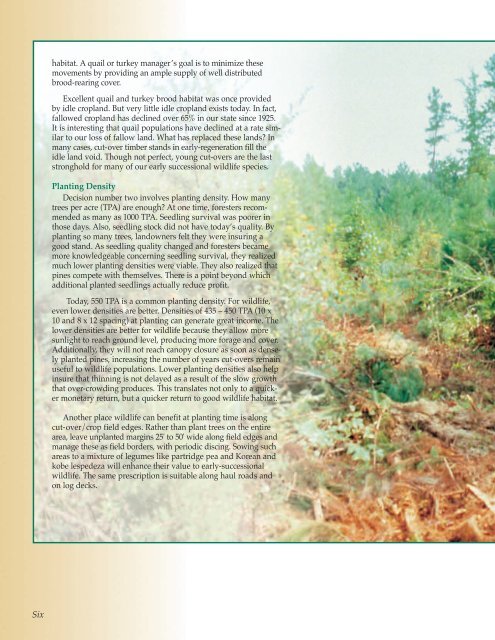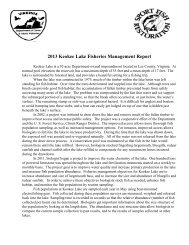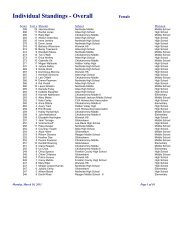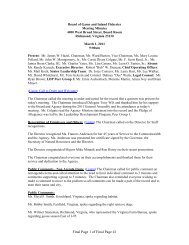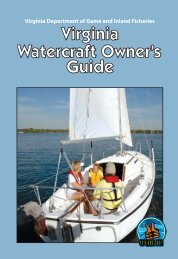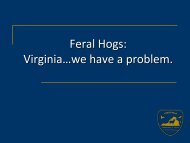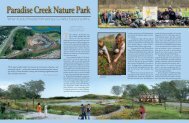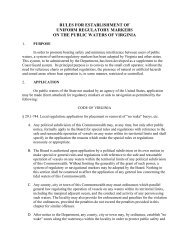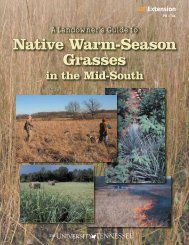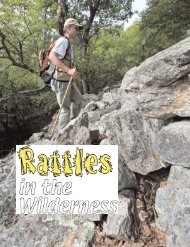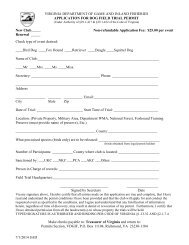Managing Pines for Profit and Wildlife - Virginia Department of ...
Managing Pines for Profit and Wildlife - Virginia Department of ...
Managing Pines for Profit and Wildlife - Virginia Department of ...
You also want an ePaper? Increase the reach of your titles
YUMPU automatically turns print PDFs into web optimized ePapers that Google loves.
habitat. A quail or turkey manager’s goal is to minimize thesemovements by providing an ample supply <strong>of</strong> well distributedbrood-rearing cover.Excellent quail <strong>and</strong> turkey brood habitat was once providedby idle cropl<strong>and</strong>. But very little idle cropl<strong>and</strong> exists today. In fact,fallowed cropl<strong>and</strong> has declined over 65% in our state since 1925.It is interesting that quail populations have declined at a rate similarto our loss <strong>of</strong> fallow l<strong>and</strong>. What has replaced these l<strong>and</strong>s? Inmany cases, cut-over timber st<strong>and</strong>s in early-regeneration fill theidle l<strong>and</strong> void. Though not perfect, young cut-overs are the laststronghold <strong>for</strong> many <strong>of</strong> our early successional wildlife species.Planting DensityDecision number two involves planting density. How manytrees per acre (TPA) are enough? At one time, <strong>for</strong>esters recommendedas many as 1000 TPA. Seedling survival was poorer inthose days. Also, seedling stock did not have today’s quality. Byplanting so many trees, l<strong>and</strong>owners felt they were insuring agood st<strong>and</strong>. As seedling quality changed <strong>and</strong> <strong>for</strong>esters becamemore knowledgeable concerning seedling survival, they realizedmuch lower planting densities were viable. They also realized thatpines compete with themselves. There is a point beyond whichadditional planted seedlings actually reduce pr<strong>of</strong>it.Today, 550 TPA is a common planting density. For wildlife,even lower densities are better. Densities <strong>of</strong> 435 – 450 TPA (10 x10 <strong>and</strong> 8 x 12 spacing) at planting can generate great income. Thelower densities are better <strong>for</strong> wildlife because they allow moresunlight to reach ground level, producing more <strong>for</strong>age <strong>and</strong> cover.Additionally, they will not reach canopy closure as soon as denselyplanted pines, increasing the number <strong>of</strong> years cut-overs remainuseful to wildlife populations. Lower planting densities also helpinsure that thinning is not delayed as a result <strong>of</strong> the slow growththat over-crowding produces. This translates not only to a quickermonetary return, but a quicker return to good wildlife habitat.Another place wildlife can benefit at planting time is alongcut-over/crop field edges. Rather than plant trees on the entirearea, leave unplanted margins 25' to 50' wide along field edges <strong>and</strong>manage these as field borders, with periodic discing. Sowing suchareas to a mixture <strong>of</strong> legumes like partridge pea <strong>and</strong> Korean <strong>and</strong>kobe lespedeza will enhance their value to early-successionalwildlife. The same prescription is suitable along haul roads <strong>and</strong>on log decks.Six


